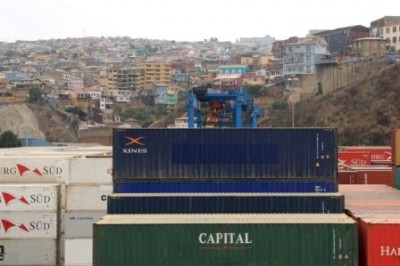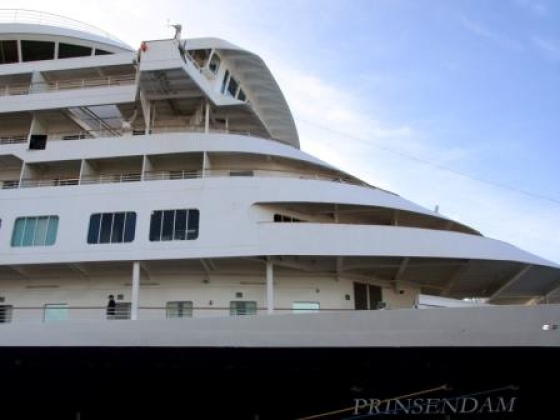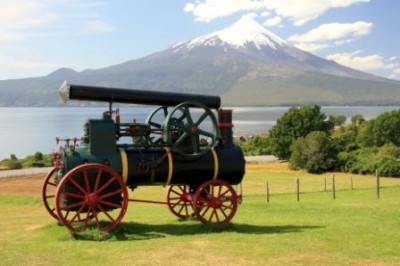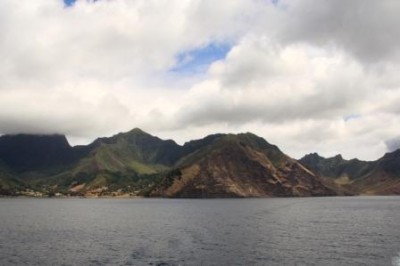Het probleem met gewone Goden is dat je er kwaad kan op worden. Dat is het voordeel met de “God van Spinoza”, waarin ook Einstein veel vertrouwen had. Die god doet niets slecht – en ook niets goed. Hij zorgt er enkel voor dat dingen gebeuren, onder andere het weer.
Ik was vanmorgen, met moeite, maar desalniettemin om 6u30 wakker en, op pure wilskracht, om 6u45 uit bed, zoals afgesproken (met mezelf). Tja, ValParaíso had weinig met een paradijs gemeen: het was nog donker natuurlijk maar de wolken, de nevel en nattigheid waren zichtbaar en/of voelbaar. De trip naar de Acongagua lag in de weegschaal … wel of niet? Hoe lang wachten om te beslissen? Wie weet er meer over het weer?
Eerst ontbijten, misschien ging daardoor ook mijn hoofdpijn weg. Ook dat, ja. Ik ben er bijna zeker van dat ze te wijten is aan de wijn die we op de rodeo-hacienda hebben voorgeschoteld gekregen. Na enkele teugen – grote sipjes – had ik een onderbewust gevoel van “oppassen”. Zo een gevoel is me niet vreemd, ik denk dat het te maken heeft met één of andere smaakpapil die sulfieten, of andere ongezonde chemicaliën herkend en een waarschuwing naar de bovenkamer stuurt. Omdat er gisteren aan tafel nergens water te bespeuren was (en het mijne zat veilig opgeborgen in de autobus…), heb ik wat veel van dat onverkwikkelijk spul gedronken en zie … hoofdpijn, in de rechterbovenvoorkamer. Typisch.

Omdat er in dit onparadijselijk oord geen verandering in de lucht kwam, heb ik de Chileense Meteorologische website geconsulteerd en … de vooruitzichten voor vandaag waren “nebloso” en “tarde: chubascos”, Spaans voor helemaal bewolkt en buien in de (late) namiddag. Met al die informatie was de Acongagua van dichterbij bekijken geen optie. Een bediende in de terminal, die tevens fotograaf was, had me gisteravond nog omstandig uitgelegd dat er, zelfs in Portillo – dat is bij de lagune aan de voet zelf van de Acongagua – enkel bij helder weer iets te zien was. Dat zal wel, het is met de Matterhorn in Zermatt niet anders.
Voilà, een paar honderd dollar gespaard en een A gemist. Dat laatste is een beetje overtrokken want de “A” betekent ook de Andes — en die is nog lang, en nog lang hoog. Mijn laatste kans komt in Quito (vandaag over acht dagen), en de eerstvolgende gelegenheid is op de grens van Chili en Peru, binnen twee dagen. De woestijn zal daar wel niet in de weg liggen zeker? En regen is daar al in geen jaren gevallen, dus de wolken zullen wel afwezig zijn. Kortom, het zal allemaal wel loslopen.
 Alles bij mekaar hebben we in Chili meer tegenslag dan geluk gehad en dat heeft alles met het weer te maken. Hoewel er aan het einde van de Grote Oceaan uiteraard veel neerslag valt, had ik toch verwacht dat er meer zonnige perioden zouden zijn. Met andere woorden, dat de regen niet te veel nevel en mist en treurnis zou brengen, maar gewoon grote plensbuien. Eigenlijk heeft Zuid Chili in dat opzicht meer weg van West Europa – aan het einde van de Minder Grote Oceaan.. Er zal niets anders opzitten dan deze natuurschone streek nogmaals te komen bezoeken.
Alles bij mekaar hebben we in Chili meer tegenslag dan geluk gehad en dat heeft alles met het weer te maken. Hoewel er aan het einde van de Grote Oceaan uiteraard veel neerslag valt, had ik toch verwacht dat er meer zonnige perioden zouden zijn. Met andere woorden, dat de regen niet te veel nevel en mist en treurnis zou brengen, maar gewoon grote plensbuien. Eigenlijk heeft Zuid Chili in dat opzicht meer weg van West Europa – aan het einde van de Minder Grote Oceaan.. Er zal niets anders opzitten dan deze natuurschone streek nogmaals te komen bezoeken.
Terwijl ik over de overweldigende Andes panorama’s (nog) geen zinnig woord kan zeggen, lijkt het me interessant om iets over de economie te vertellen, en meer bepaald over de menselijke aspecten ervan. Chili heeft – zoals we dat in België kennen – twee werknemersstatuten, namelijk arbeiders en … (hoe konden jullie het allemaal raden) bedienden. Hier zijn de arbeiders, ook per uur betaald, doch zij zijn tegelijk en per definitie de minderverdieners. Een arbeider verdient tussen de 270€ en de 460€ per maand. De bediende, per maand betaald, heeft een loon dat varieert tussen 600€ en 1500€. In Chili telt één werkjaar twaalf maanden, inclusief drie weken betaald verlof, en de grote meerderheid van de vrouwen werkt niet in loondienst.
En de levensduurte dan, zal men vragen? Ik heb geen officiële getallen daarover maar wel wat gesprekken gehad. Groenten en fruit, alsook vlees en vis zijn rijkelijk voorradig en kosten veel minder dan in West-Europa. Al de rest kost evenveel, of meer. Bijvoorbeeld, benzine kost 1.20€ per liter (wordt bijna allemaal ingevoerd). De auto’s zijn veelal Japans en duur, bijgevolg ook klein en overjarig. Ik kan me niet herinneren dat ik in Zuid-Amerika al een BMW heb gezien, wel één Mercedes SUV.
A1ls ik het goed heb, dan ligt de armoedegrens in België rond de 14000€ per jaar, per gezin. Dat maakt alle arbeidersgezinnen van Chili, en een aanzienlijk deel van de loontrekkenden, volgen Belgische normen armoezaaiers, met dien verstande dat ze beslist geen honger lijden wegens onvoldoende middelen. Wat de arbeiders – en zij alleen – door de Staat voorgeschoten krijgen, dat is een sociale woning, variërend tussen de 60 en 90 vierkante meter, afhankelijk van gezinsgrootte. Daarvoor betalen ze maximaal 100€ huur per maand, gedurende omzeggens de rest van hun leven. (Het is eigenlijk een levenslange huur; de huizen in kwestie lijken me na vijftig jaar niet meer overeind te blijven!).
Als we inderdaad reizen om te leren, dan kan je uit deze informatie van alles leren. Voorlopig onthoud ik eruit dat Chili, over zijn geheel genomen en met zijn zeventien miljoen inwoners, het tweede welvarendste land van Zuid-Amerika is, na Brazilië (Venezuela heeft uiteraard veel olie, waarvan vooral de vriendjes van Chavez meeprofiteren, en zodoende een hoger BNP per inwoner). Ik stel node vast dat meer dan 50% van de Chilenen onder de Belgische armoedegrens leeft. Wat is er dan merkwaardig aan de Belgische armoedegrens, of ligt het aan de Chileense economie?
Stof tot nadenken, voor twee dagen “at Sea”.
Prinsendam, donderdag 24 februari 2011
Eindelijk terug wat tijd voor wat contemplatiever orde …

 Driving past the various lake beaches on a summer Sunday afternoon, I was struck by the skin color of the locals: contrary to other parts of South America that I have visited so far, the general tendency was for pale skins. Indeed, I have seen a few real redheads, as they also sported authentic freckles! I have been told that very few Indians (Mapiche) survived the early colonization and that the area, from the coast all the way to the Lake Llanquihue, has been settled by Germans primarily. Traces of that influence could be seen in building styles and store names. I also detected a fire brigade truck that had “Feuerwehr” written across it!
Driving past the various lake beaches on a summer Sunday afternoon, I was struck by the skin color of the locals: contrary to other parts of South America that I have visited so far, the general tendency was for pale skins. Indeed, I have seen a few real redheads, as they also sported authentic freckles! I have been told that very few Indians (Mapiche) survived the early colonization and that the area, from the coast all the way to the Lake Llanquihue, has been settled by Germans primarily. Traces of that influence could be seen in building styles and store names. I also detected a fire brigade truck that had “Feuerwehr” written across it! Rather than spending time in the tourist area with all the gift shops (imported from the mainland), I decided to go for gold: Alexander’s Lookout or “Mirador Selkirk”. The info board stated 2700m. Since that could not be the height, it had to be the length. After fifteen minutes uphill I had left the houses behind me, as well as all (imagined) competitors. Another fifteen minutes and my heartbeat was way up and my shirt started to change color. The first patch of rain forest had been traversed and, the path turned less steep. Another half a mile I detected a lookout point, a couple of hundred meters below the saddle.
Rather than spending time in the tourist area with all the gift shops (imported from the mainland), I decided to go for gold: Alexander’s Lookout or “Mirador Selkirk”. The info board stated 2700m. Since that could not be the height, it had to be the length. After fifteen minutes uphill I had left the houses behind me, as well as all (imagined) competitors. Another fifteen minutes and my heartbeat was way up and my shirt started to change color. The first patch of rain forest had been traversed and, the path turned less steep. Another half a mile I detected a lookout point, a couple of hundred meters below the saddle. 